Essential Oils for Digestion — Natural Support for a Healthy Gut

Digestion is at the Heart of Good Health
Every bite of food we eat triggers a remarkable chain of events in the digestive system, breaking down each delicious bite into usable nutrients that fuel our bodies and lives. What we eat provides us with energy, repairs our tissues, and keeps our immune system strong. It helps our brain stay alert and sharp, and even contributes to our emotional wellbeing.
As an RN, I’m constantly amazed at how the body works tirelessly to turn food into energy, which we then use to build our lives.
But the process isn’t always smooth. In the United States alone, approximately 60–70 million people live with ongoing gastrointestinal issues that impact their daily lives (National Institute of Diabetes and Digestive and Kidney Diseases [NIDDK], 2014).
The good news is, natural support can make a real difference. Essential oils, with their antispasmodic, soothing, and stimulating properties, offer gentle ways to encourage a healthy GI tract and more comfortable digestion.
In this post, we’ll explore:
How the digestive process works (an easy guide for aromatherapists).
The ways essential oils can support each stage of digestion.
Specific oils to use for common concerns (like cramps, nausea, or sluggish digestion).
Easy recipes you can try at home.
Understanding the Digestive System
Before diving into essential oils, it helps to understand the incredible journey food takes through the body.
It begins in the mouth, where chewing mixes food with saliva, a fluid rich in enzymes that start breaking down starch. Once swallowed, food travels down into the stomach, where powerful digestive juices and stomach acid transform it into a semi-liquid mixture called chyme. The stomach and muscles churn this mixture, preparing it for the small intestine.
In the small intestine, enzymes from the pancreas, along with bile from the liver and gallbladder, continue the breakdown of carbohydrates, protein, and fat. Here, nutrients such as amino acids, fatty acids, vitamins, minerals, and water are absorbed into the bloodstream. Whatever remains moves into the large intestine, where fluids are reabsorbed, stool is formed, and waste exits through the anus.
This complex digestive tract relies on peristalsis—the rhythmic muscle contractions that move food and fluids forward.
In short, the digestive system is not only about processing food but also about creating energy, delivering essential nutrients, and maintaining balance. As you can imagine, numerous issues can arise throughout this process, such as indigestion, inefficient bile flow, stomach irritation or ulcers, infection by pathogenic bacteria (like H. pylori), or inflammation of the small or large intestine. Even subtle disruptions (like slowed peristalsis or an imbalance in gut microbes) can affect nutrient absorption and overall wellbeing.
Understanding how each part of the digestive system works helps us see why supporting it with gentle, natural tools, like essential oils, can make a meaningful difference in overall digestive health.
How Essential Oils Support Digestion
Essential oils can play a powerful supportive role in digestion. Their natural chemical compounds interact with smooth muscle, enzymes, and the nervous system to maintain balance in the gastrointestinal tract. While they don’t replace medical care or medications (such as proton pump inhibitors) when those are needed, many people find essential oils to be a gentle, plant-based complement for common digestive concerns.
Here are some of the main ways essential oils can support digestion:
Calming the GI Tract with Antispasmodic Action
Digestive discomfort often comes from spasms in the stomach or intestines. Relaxing these smooth muscles can ease cramping, bloating, and discomfort while supporting healthy peristalsis (the wave-like movement that pushes food along the intestines).
Supporting Digestive Juice and Enzymes
Healthy digestion depends on the right balance of stomach acid, saliva, bile, and secretions from the pancreas. Certain oils can help stimulate digestive secretions, supporting the stomach and small intestine in breaking down food into absorbable nutrients that the body relies on for energy and tissue repair.
Liver and Gallbladder Support
The liver and gallbladder play a central role in processing fat and fatty acids, producing bile, and supporting detoxification. If we can naturally encourage healthy bile flow, we help the body handle rich foods more comfortably and reduce the sluggish, heavy feeling that sometimes follows heavy meals.
Soothing & Protecting the Stomach Lining
Nausea, regurgitation, or stomach lining irritation are common digestive problems. Certain essential oils can provide comforting aromatic support, especially when inhaled, massaged over the belly, or taken internally (using a safe delivery method; I have a tip for you in the recipes section). Their balancing effect on the stomach can reduce queasiness and encourage calmer digestion.
Stress, the Gut, and the Soothing Power of Aromas
It’s impossible to talk about digestive health without mentioning stress. The gut and brain are in constant communication through what’s known as the gut–brain axis. When you’re stressed, your body shifts into “fight or flight” mode. Blood flow is redirected away from the gut, stomach acid secretion decreases, and gut motility can become irregular. For many people, that translates into indigestion, cramping, or even serious chronic issues.
Fortunately, essential oils shine at calming stress and anxiety! We are aware of numerous studies that have shown these benefits, helping the nervous system shift into its “rest and digest” mode. Think of it this way: when your mind feels safe, your body can relax. Then digestion can get back on track. As an RN and aromatherapist, I have heard of many cases of serious digestive issues being resolved when stress and anxiety are finally addressed (such as this one).
Essential Oils for Digestive Support
Each essential oil has its own unique chemistry that can support the digestive system in different ways. I had a hard time choosing oils to feature in this list, but I’ve managed to narrow it down to six of the most effective oils for easing discomfort, improving digestive function, and protecting the gastrointestinal tract. These are the oils I reach for again and again when blending for myself, my family, and others.
Cardamom Oil (Elettaria cardamomum)
Cardamom oil has been prized for centuries as a spice and a digestive aid, and modern research helps explain why. Studies show that cardamom oil has both gut-stimulating and gut-calming effects, depending on the body’s needs, thanks to its interaction with cholinergic and calcium channels (Gilani et al. 2008). It has demonstrated antispasmodic action on smooth muscle, helping to relax cramping in the intestines (Al-Zuhair et al. 1996), and can reduce gas, colic, and flatulence.
Cardamom also shines in providing relief from nausea. Inhalation of cardamom oil, often in blends with ginger or peppermint, has been shown in clinical settings to reduce postoperative nausea and vomiting (Battaglia, 2018). Its aromatic compounds appear to block certain pathways of nausea while calming the nervous system.
Additionally, cardamom may have a protective effect on the liver, influencing detoxification enzymes and promoting healthy bile flow.
Safety notes: If oxidized, cardamom oil may cause irritation or sensitization. It may antidote homeopathic remedies. Use with caution on children between 5-10 years old. Care must be taken when using it for asthmatics.
Learn fun ways to use cardamom on our blog!
Coriander Oil (Coriandrum sativum)
The second oil on our list is gentle and slightly sweet. Coriander seed oil offers carminative and antispasmodic benefits that make it helpful for bloating, abdominal pain, and indigestion. In a small clinical trial, a blend containing coriander (Carmint) significantly reduced abdominal pain and bloating in patients with irritable bowel syndrome (Vejdani et al., 2006).
Coriander oil also appears to stimulate the liver and pancreas, supporting enzymes and bile production, which aids the breakdown of food (Battaglia, 2018). This makes it a good choice for individuals with sluggish digestion or a low appetite. Its calming qualities may also ease nausea and support better sleep, giving the gut a chance to rest and repair.
Here are 3 ways to use coriander oil in your life!
Sweet Orange (Citrus sinensis)
Sweet orange oil is famous for its ability to bring smiles to our faces . . . and it has a natural affinity for digestion. Rich in d-limonene, it has been studied for its ability to protect the stomach from irritation and even ulcer formation. In animal studies, d-limonene boosted protective mucus, increased stress-resistance proteins (like HSP-70), and supported prostaglandin activity that shields the stomach from injury (Rozza et al., 2011).
Traditionally, sweet orange oil is used to calm spasms and balance the gut, making it helpful for bowel regularity (Battaglia, 2018). It also supports healthy bile flow. And on an emotional level, its bright, sweet aroma helps reduce anxiety and depression (Komori et al. 1995), which often goes hand-in-hand with digestive upset.
Learn more about sweet orange at our full profile of its benefits & uses!
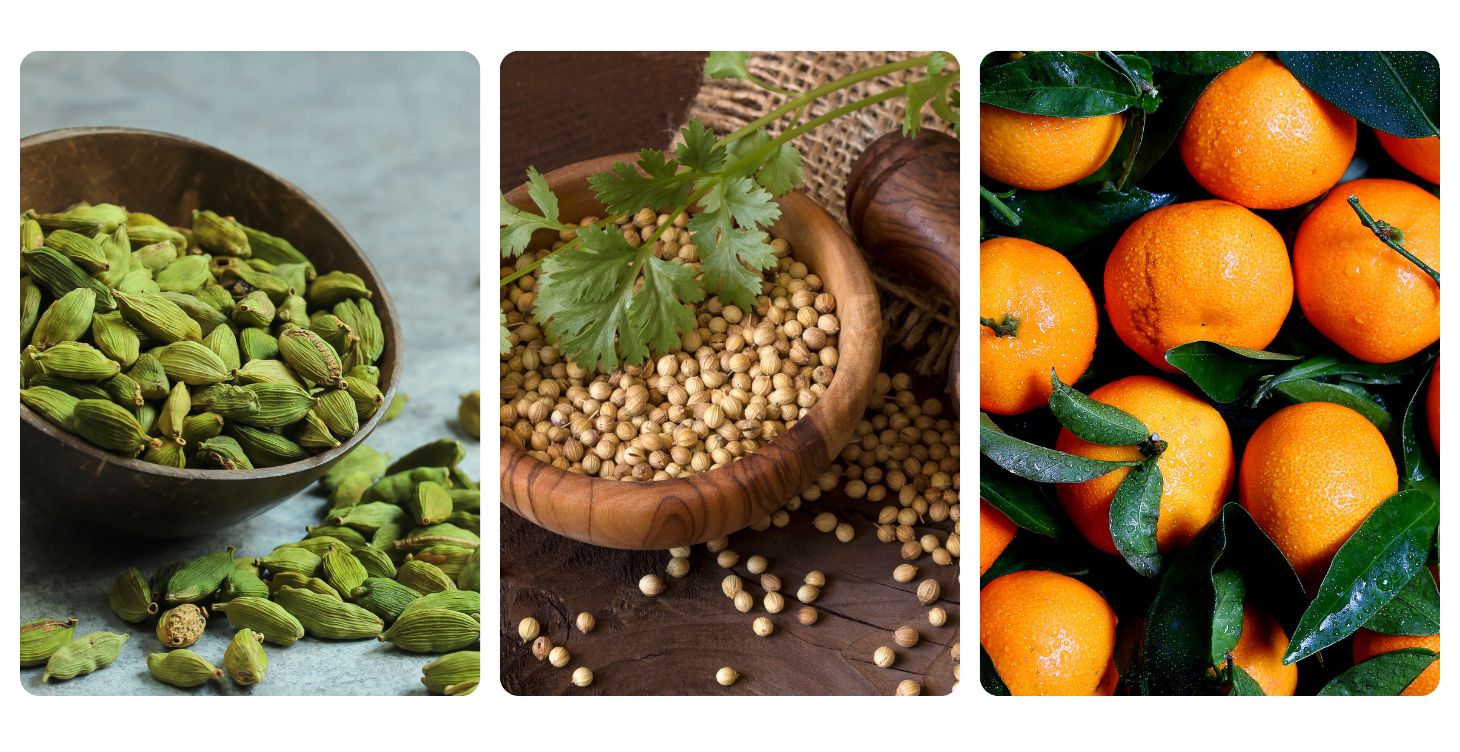
Ginger (Zingiber officinale)
One of the most extensively studied digestive oils, ginger oil is renowned for its ability to relieve nausea, whether it’s caused by motion sickness, morning sickness, or postoperative nausea and vomiting. In one clinical study, a topical blend containing ginger reduced nausea in 75% of surgical patients within 30 minutes (De Pradier, 2006).
Ginger oil’s benefits extend beyond nausea. Its gingerols and sesquiterpenes stimulate bile secretion from the liver, enhance GI motility, and may help protect against ulcers and inflammation in the stomach (Battaglia, 2018). This makes ginger a versatile oil for indigestion, flatulence, sluggish digestion, or chronic gastritis.
Ginger is a beautiful, multifaceted oil. Discover more ways to use it in this post.
Safety note: Although non-toxic, ginger oil may cause irritation for individuals with sensitive skin. Use in low dilution when applying to the skin, such as in baths or massage oils.
Roman Chamomile (Chamaemelum nobile)
Roman chamomile oil is a classic herb known for its soothing properties, which help calm the stomach and nerves. Its essential oil has strong antispasmodic activity, helping to ease cramping and diarrhea (Franchomme & Pénoël, 1990). It also has sedative and anxiolytic effects (Cho et al., 2013; Rossi et al., 2018), which makes it particularly useful when digestive upset is tied to stress or anxiety.
Roman chamomile is gentle enough for children and is often used to relieve colic, indigestion, and a poor appetite (although we rarely recommend using essential oils for babies). Its calming nature makes it a perfect choice for rest and restoration.
Here are 3 ways Roman chamomile benefits the belly (and what to blend it with).
Cinnamon Bark (Cinnamomum verum)
Cinnamon bark oil, rich in cinnamaldehyde, is both stimulating and protective for the digestive system. Research in mice suggests cinnamaldehyde may reduce inflammation in the small intestine, modulate immune responses, and even help protect against infection (Zhu et al., 2021).
Traditionally, cinnamon bark oil has been regarded as a powerful GI stimulant that enhances gastric juices, appetite, and overall digestion (Battaglia, 2018). It also has strong antimicrobial properties, helping to balance gut flora and clear out pathogens (without compromising the gut microbiome). Its spasmolytic action can relieve dyspepsia, colitis, flatulence, diarrhea, nausea, and throwing up.
Safety note: May irritate sensitive skin and mucous membranes. Because cinnamon bark oil is very potent, it must always be used in extremely low dilutions. I suggest 1 drop for every 60 mls of carrier. (This is about 0.5 drops per fl oz.) Avoid during pregnancy and breastfeeding, and avoid for children younger than 5. Avoid if you have a blood clotting issue or are on anticoagulants.
I wrote an in-depth profile of cinnamon bark oil here, and explored its vast potential as a natural antimicrobial in this post.

Other popular oils for digestion:
Peppermint Oil (Mentha × piperita) (I have a quick explanation of peppermint’s benefits in this 40-second video!)
Plai Oil (Zingiber cassumunar) (If you’re not familiar with plai, I’ll tell you about it in this short video.)
Spearmint Oil (Mentha spicata) (This belly oil recipe on YouTube includes spearmint.)
Spikenard Oil (Nardostachys jatamansi) (Spikenard is sometimes controversial, but Jenny explains how you can feel confident purchasing it.)
Sweet Basil Oil (Ocimum basilicum ct linalool) (Sweet basil contains the same component as lavender! Learn how to use it here.)
Essential Oil Recipes & Blends for Digestion
Orange’s Spiked Antispasmodic Belly Butter
This indulgent classic recipe from our blog combines sweet orange, Roman chamomile, ginger, and spikenard essential oils. Orange and Roman chamomile act as gentle antispasmodics, calming the muscles of the GI tract, while ginger encourages digestive motility, helping move food through the body efficiently. Spikenard brings a grounding, calming quality that supports both the nervous system and the gut-brain connection, perfect for easing digestive tension after a heavy meal.
Massage it onto the abdomen and lower back before a big meal to prepare the digestive system. It’s also great after overeating, when you feel bloated.
We also have a popular Digestive Belly Cream recipe on our YouTube channel!
Kids’ Tummy Soother
Gentle, safe, and comforting, this blend is designed for children ages 5 and up to help ease common digestive discomfort like bloating, tummy aches, or mild nausea. It turns tummy support into a gentle, comforting ritual, perfect for children after meals, after school, or at bedtime.
Ingredients
1 oz (28 gm) Coconut Oil (Cocos nucifera)
2 drops Roman Chamomile Oil (Chamaemelum nobile)
2 drops Sweet Orange Oil (Citrus sinensis)
1 drop Coriander Oil (Coriandrum sativum)
Directions
Gently massage onto the child’s abdomen. You can also diffuse these essential oils when the child has an upset stomach.
For children younger than 5, I suggest using hydrosols. Add 1 tsp of blood orange, peppermint, or ginger hydrosol to 8 oz of water, allowing the child to sip slowly until they feel soothed.
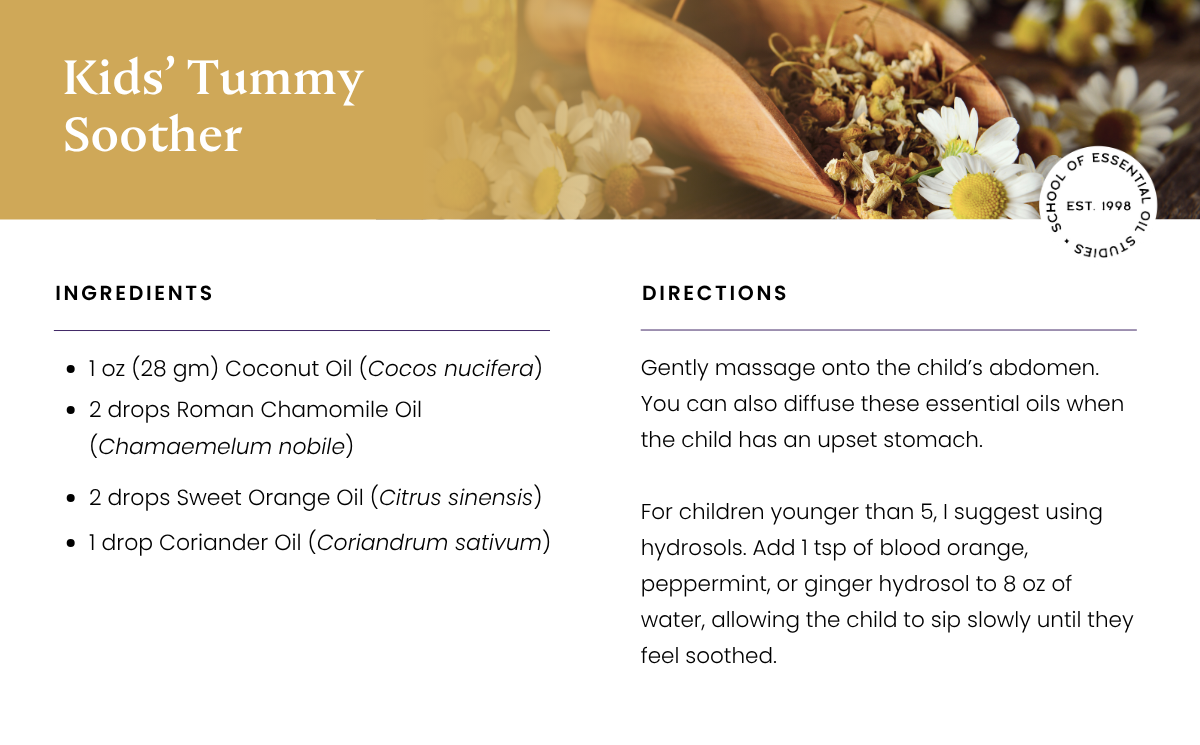
Nausea Relief Inhaler
When queasy stomachs strike (whether from motion sickness, morning sickness, or post-meal discomfort), this inhaler offers fast, targeted relief. The essential oils work together to calm digestion and reduce nausea through the olfactory and gut-brain pathways.
Ingredients
9 drops Sweet Orange Oil (Citrus sinensis)
3 drops Ginger Oil (Zingiber officinale)
2 drops Cardamom Oil (Elettaria cardamomum)
1 drop Cinnamon Bark Oil (Cinnamomum verum)
Directions
Add oils to a small inhaler. (I show you how to make an inhaler in this 45-second video.)
Inhale deeply whenever nausea strikes.
Safety: Cinnamon bark is very potent. Use only 1 drop per blend and avoid direct skin contact. Not recommended for children under 12.
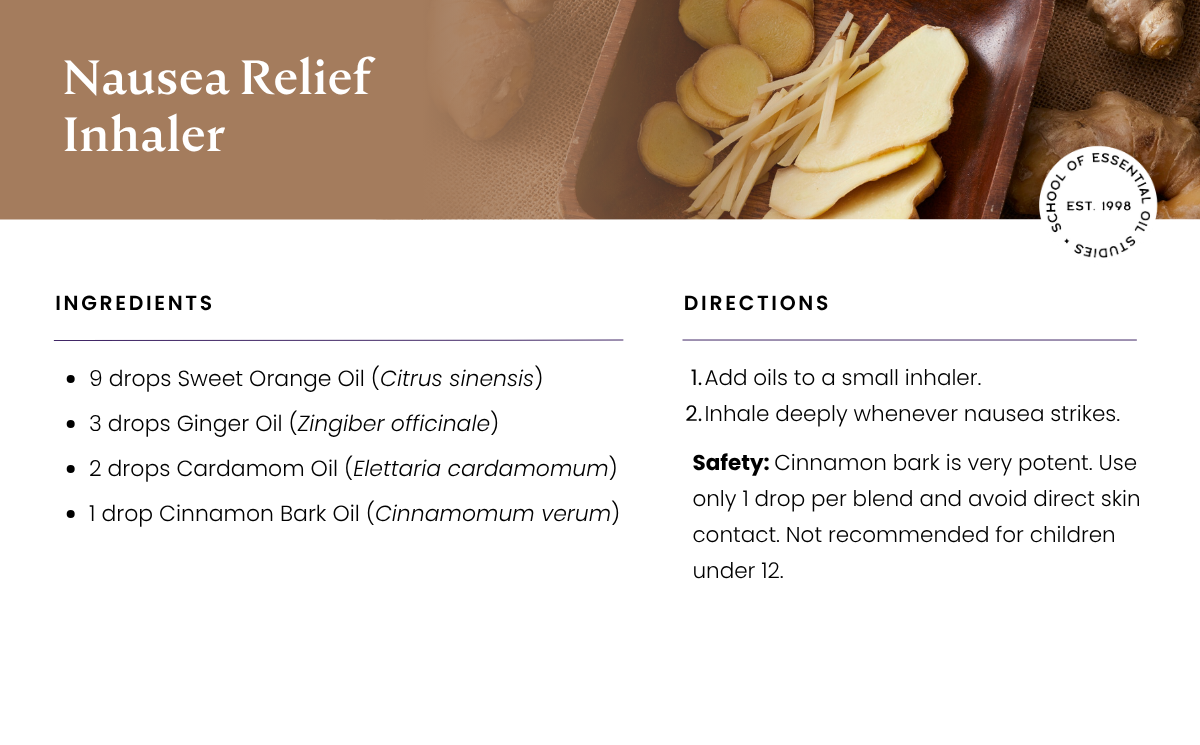
Appetite Stimulant Diffuser Blend
This cheerful, uplifting blend is designed to wake up the digestive system and encourage a healthy appetite before meals. It gently stimulates digestive juice and signals the body that it’s time to eat.
Ingredients
3 drops Cardamom Oil (Elettaria cardamomum)
3 drops Sweet Orange Oil (Citrus sinensis)
2 drops Coriander Oil (Coriandrum sativum)
Directions
Diffuse before meals (or in the dining area) to encourage digestive juices and stimulate appetite.
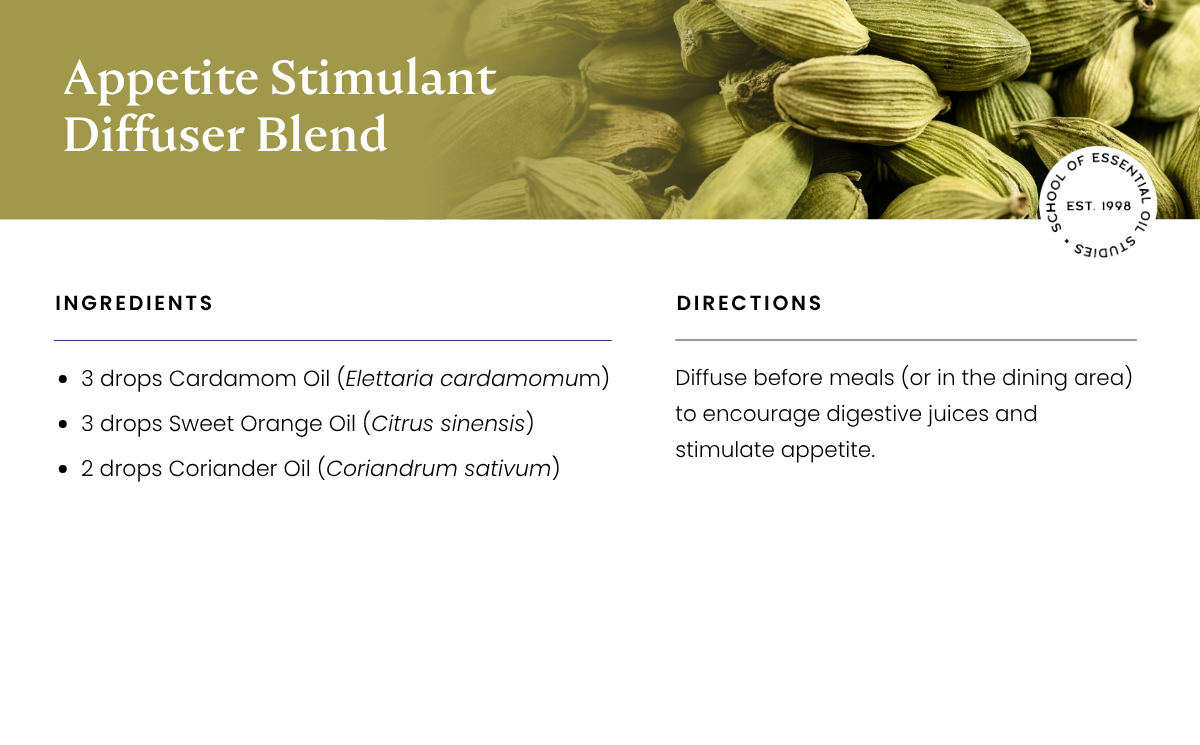
After-Meal Digestive Inhaler
Sometimes holiday feasts (or any big meal) leave us feeling overstuffed, bloated, or sluggish. This inhaler recipe from our blog offers a discreet and soothing way to support digestion, allowing you to enjoy your meal without discomfort. It helps ease bloating, encourages bile flow, and eases spasms.
Inhale deeply every 15 minutes before or after meals for extra digestive comfort.
Liver Support Oil
Your liver works hard every day to process nutrients, metabolize fats, and support detoxification, so giving it a little extra care can go a long way. This gentle, stimulating blend supports its work, encouraging healthy circulation over your liver area.
Ingredients
1 fl oz (30 ml) Sweet Almond Oil (Prunus amygdalus var dulcis)
6 drops Coriander Oil (Coriandrum sativum)
6 drops Ginger Oil (Zingiber officinale)
Directions
After eating, massage gently over the upper right abdomen (liver area) to encourage bile flow and fat metabolism. Use in slow, clockwise motions to encourage circulation.
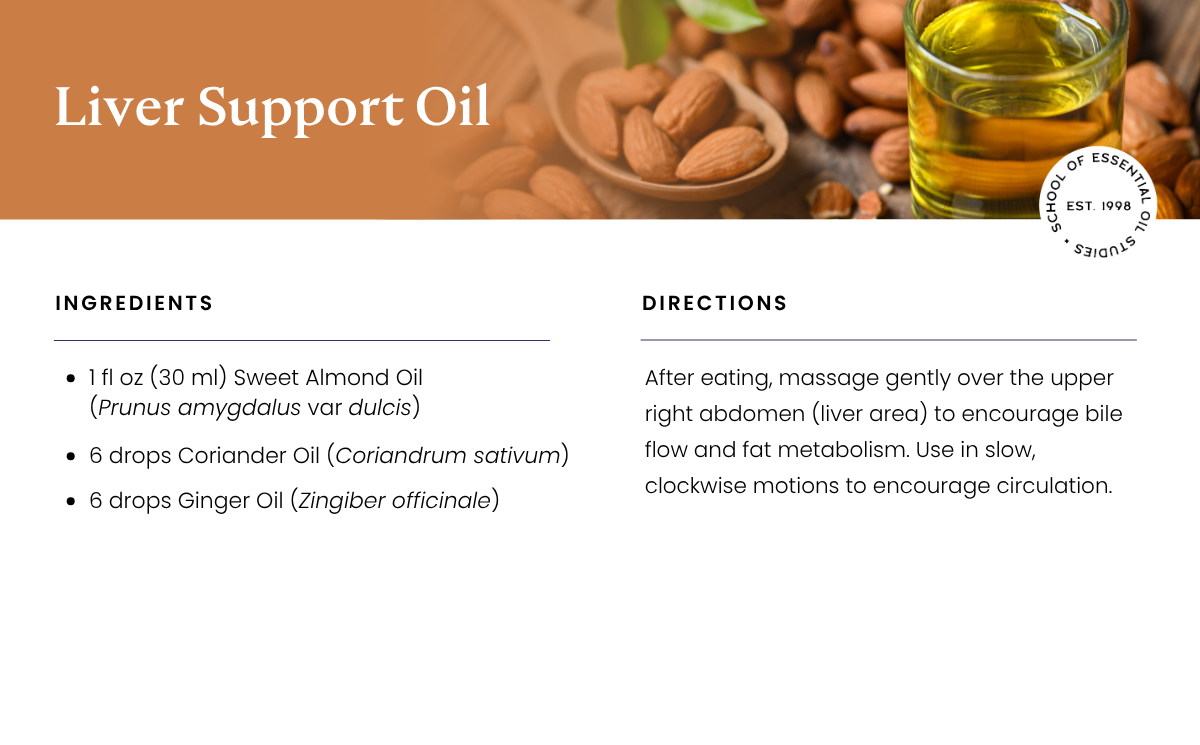
Digestive Tea Ritual
The simplest rituals can sometimes be the most soothing. This Digestive Tea Ritual uses hydrosol to gently support the body after meals, helping reduce bloating, ease mild cramps, and encourage a happy gut. Hydrosols are generally safe for internal use (even if you’re not trained to use essential oils internally). You can use either peppermint or ginger hydrosol in this tea. Both have wonderfully soothing properties for the belly. Peppermint is cooling, whereas ginger is warming, so it all depends on what experience you’re looking to create.
Just make sure your hydrosols are fresh and stored properly in a cool, dark place.
Ingredients
1 cup hot water
1 tsp peppermint hydrosol (Mentha × piperita) OR ginger hydrosol (Zingiber officinale)
Directions
Add hydrosol to hot water or honey-water. Sip slowly after meals.
Instead of using hydrosol, adults may choose to take 1 drop of peppermint oil internally by adding 1 drop of peppermint oil to 1 teaspoon of honey and stirring well. Add the blend of honey and peppermint to a cup of warm water, and sip gently.
Safety note: I don’t always recommend using essential oils internally, as it requires specific training. However, there are times when it can be very supportive. If you’re going to use this method, be sure to use honey or an edible, lipid-based carrier. I also suggest consulting with a certified aromatherapist who is trained in the internal use of essential oils.
If you’re interested in this method (and you are a certified aromatherapist), I invite you to explore the course I’ve created, Essential Oil Internal Usage Foundations.(Please note that you do need to be an ACP student or a certified aromatherapist to take this course.)
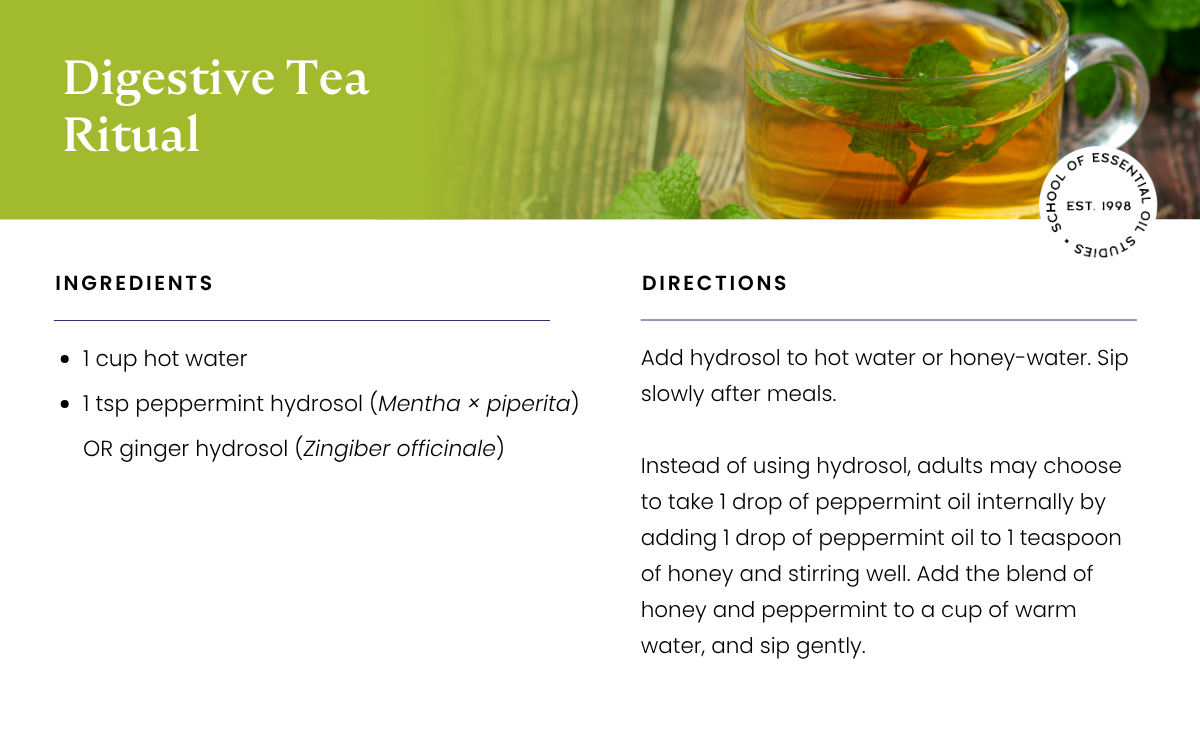
Evening Digestive Bath
After a day of feasting and celebration, your body may feel content but overstuffed, with a gentle reminder of indulgence in the form of bloating, fullness, or mild digestive discomfort. This aromatic bath ritual provides a soothing way to relax your body and support digestion as you wind down.
Stress-Calmer Roll-On for Gut Tension
Stress can have a direct impact on digestion, triggering tension in the gut, slowing gut motility, or even leading to nausea and bloating. This portable roller blend helps calm gut tension caused by stress, supports a healthy gut-brain connection, relaxes spasms and tension, and soothes your nervous system.
It’s a simple, easy-to-use ritual for busy days, travel, or anytime you want a moment of calm while supporting your digestive health.
Castor Oil Pack for Digestive Support
The castor oil pack is a classic home remedy! It has long been trusted for supporting digestive function, especially when cramps or constipation are an issue. The combination of gentle heat and ricinoleic acid from castor oil helps relax the intestinal muscles and stimulate smooth movement through the bowels.
Apply a thin layer of warm castor oil directly to the abdomen.
Cover with a piece of flannel or a soft cloth, then apply a warm heating pad on top for 20–30 minutes.
Jenny and I did a live event about castor oil packs, which was a lot of fun! Join us and learn all about it here.
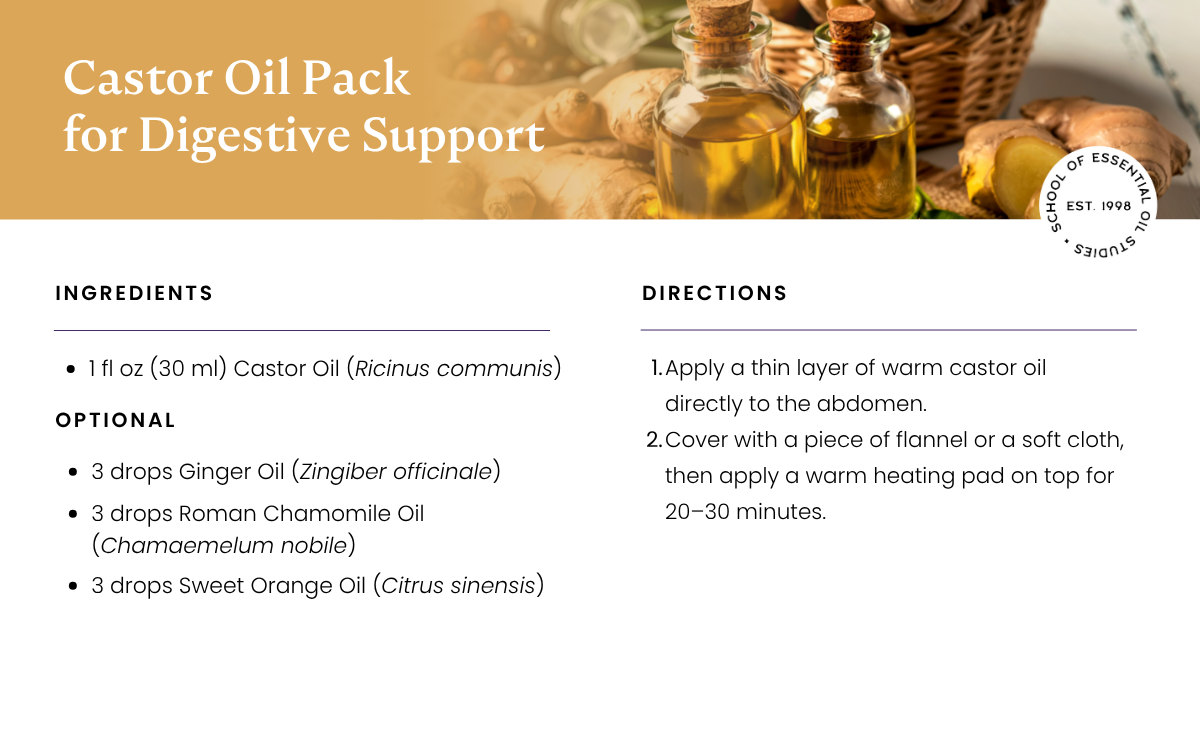
Optional: Castor Oil Blend with Essential Oils
You can combine castor oil with antispasmodic or digestive-stimulating essential oils.
Try this blend!
1 fl oz (30 ml) Castor Oil (Ricinus communis)
3 drops Ginger Oil (Zingiber officinale)
3 drops Roman Chamomile Oil (Chamaemelum nobile)
3 drops Sweet Orange Oil (Citrus sinensis)
Directions
Follow the directions for a castor oil pack.
Safety Notes
Do not ingest castor oil unless directed by a healthcare provider. Topical use is generally considered safe.
Avoid use on broken skin or during pregnancy without medical supervision.
Lifestyle Tips for Supporting Digestion (Beyond Oils)
While essential oils can offer targeted support for digestion, they are most effective when used as part of a balanced and healthy lifestyle. (For example, if you have an unhealthy diet, feel overwhelmed with stress, and don’t drink enough water, your aromatherapy blends can only do so much.)
Good habits form the foundation of long-term digestive wellness.
Stay Hydrated
Water and other healthy liquids are essential for proper digestion. Adequate hydration helps food move smoothly through the small and large intestines, supports enzyme function, and facilitates regular bowel movements. Herbal teas, broths, and hydrosols, such as peppermint hydrosol, can also contribute to gentle digestive support.
Focus on Whole Foods
Eating a diet rich in fruits, vegetables, proteins, healthy fats, and complex carbohydrates ensures your body has the nutrients necessary for healthy digestion. Fiber from fruits and vegetables supports a happy gut, while proteins, fat, and starches provide the building blocks for energy and nutrient absorption. Including fermented foods like yogurt or kefir can also support healthy gut flora.
Support Enzymes and Acid Balance Naturally
Digestive enzymes and stomach acid are crucial for breaking down food and absorbing nutrients. Eating slowly, chewing thoroughly, and including naturally enzyme-rich foods like pineapple, papaya, or fermented vegetables can enhance your body’s digestive process. Avoiding excessive reliance on medications like proton pump inhibitors can help maintain a natural acid balance when appropriate, under the guidance of a healthcare provider.
Gentle Movement
Light physical activity, such as walking, stretching, or yoga, stimulates gut motility and encourages healthy circulation throughout the gut. Even a short walk after meals can help move food along the digestive tract, reduce bloating, and support regularity.
Tip: Mindfulness while eating (slowing down, savoring flavors, and tuning into hunger cues) can also enhance digestion by signaling your body to produce the digestive juices, enzymes, and bile needed for efficient nutrient absorption.
My Takeaway
Sometimes, the simplest, plant-based tools are the most effective. Essential oils provide a powerful way to support your digestive system, enabling your body to break down food, absorb nutrients, and maintain steady energy levels throughout the day. From antispasmodic blends that ease bloating to stimulating oils that support appetite, these natural allies work gently yet effectively alongside your body’s own processes.
The recipes in this post are meant to be exploratory, fun, and supportive. Try them mindfully, pay attention to how your body responds, and adjust as needed. Everyone’s digestive system is unique, and the key is listening to your body, not forcing it to fit a formula.
Remember, essential oils are a complement, not a replacement, for a balanced diet, adequate hydration, regular physical activity, and professional medical guidance. If you have ongoing digestive concerns, consider consulting a healthcare professional or a certified aromatherapist experienced in digestive support.
Ultimately, nurturing your digestive health is about connection, care, and a sense of curiosity. With the right combination of lifestyle habits and thoughtfully chosen essential oils, you can create a digestive routine that brings comfort to your daily life.
REFERENCES
Al-Zuhair, H., El-Sayeh, B., Ameen, H. A., & Al-Shoora, H. (1996). Pharmacological studies of cardamom oil in animals. Pharmacological Research, 34(1–2), 79–82. https://doi.org/10.1006/phrs.1996.0067
Battaglia, S. (2018) The Complete Guide to Aromatherapy (Third Edition) Vol I: Foundations & Materia Medica. Zillmere, QLD, Australia. Black Pepper Creative Party, Ltd.
Cho MY, Min ES, Hur MH, Lee MS. (2013) Effects of aromatherapy on the anxiety, vital signs, and sleep quality of percutaneous coronary intervention patients in intensive care units. Evidence Based Complementary and Alternative Medicine. 2013;2013:381381. doi: 10.1155/2013/381381. Epub 2013 Feb 17. PMID: 23476690; PMCID: PMC3588400.
De Pradier, E. (2006) A trial of a mixture of three essential oils in the treatment of postoperative nausea and vomiting. International Journal of Aromatherapy 16, 1, 15-20.
Franchomme, P. and Pénoël, D. (1990) L’aromathérapie Exactement. Limoges: Jallois.
Gilani, A. H., Jabeen, Q., Khan, A. U., & Shah, A. J. (2008). Gut modulatory, blood pressure lowering, diuretic and sedative activities of cardamom. Journal of ethnopharmacology, 115(3), 463-472.
Jamal, A., Javed, K., Aslam, M., & Jafri, M. A. (2006). Gastroprotective effect of cardamom, Elettaria cardamomum Maton. fruits in rats. Journal of ethnopharmacology, 103(2), 149-153.
Komori, T., Fujiwara, R., Tanida, M., Nomura, J., & Yokoyama, M. M. (1995). Effects of citrus fragrance on immune function and depressive states. Neuroimmunomodulation, 2(3), 174–180. https://doi.org/10.1159/000096889
Mahady, G. B., Pendland, S. L., Stoia, A., Hamill, F. A., Fabricant, D., Dietz, B. M., & Chadwick, L. R. (2005). In vitro susceptibility of Helicobacter pylori to botanical extracts used traditionally for the treatment of gastrointestinal disorders. Phytotherapy research, 19(11), 988-991.
National Institute of Diabetes and Digestive and Kidney Diseases. (2014, November). Digestive diseases statistics for the United States. National Institutes of Health. https://www.niddk.nih.gov/health-information/health-statistics/digestive-diseases
Ramos, C. A. F., Sá, R. C. D. S., Alves, M. F., Benedito, R. B., de Sousa, D. P., Diniz, M. F. F. M., Araújo, M. S. T., & de Almeida, R. N. (2015). Histopathological and biochemical assessment of d-limonene-induced liver injury in rats. Toxicology reports, 2, 482–488. https://doi.org/10.1016/j.toxrep.2015.01.001
Rozza, A. L., Moraes, T.deM., Kushima, H., Tanimoto, A., Marques, M. O., Bauab, T. M., Hiruma-Lima, C. A., & Pellizzon, C. H. (2011). Gastroprotective mechanisms of Citrus lemon (Rutaceae) essential oil and its majority compounds limonene and β-pinene: involvement of heat-shock protein-70, vasoactive intestinal peptide, glutathione, sulfhydryl compounds, nitric oxide and prostaglandin E₂. Chemico-biological interactions, 189(1-2), 82–89. https://doi.org/10.1016/j.cbi.2010.09.031
Rossi T, Melegari M, Bianchi A, Albasini A, Vampa G. (1988) Sedative, anti-inflammatory and anti-diuretic effects induced in rats by essential oils of varieties of Anthemis nobilis: a comparative study. Pharmacological Research Communications. 1988 Dec;20 Suppl 5:71-4. doi: 10.1016/s0031-6989(88)80844-0. PMID: 3247357.
Sándor, Z., Mottaghipisheh, J., Veres, K., Hohmann, J., Bencsik, T., Horváth, A., Kelemen, D., Papp, R., Barthó, L., & Csupor, D. (2018). Evidence Supports Tradition: The in Vitro Effects of Roman Chamomile on Smooth Muscles. Frontiers in pharmacology, 9, 323. https://doi.org/10.3389/fphar.2018.00323
Tisserand, R., Young, R. (2014) Essential Oil Safety, Second Edition. Edinburgh: Churchill Livingstone
Tóth, B., Lantos, T., Hegyi, P., Viola, R., Vasas, A., Benkő, R., Gyöngyi, Z., Vincze, Á., Csécsei, P., Mikó, A., Hegyi, D., Szentesi, A., Matuz, M., & Csupor, D. (2018). Ginger (Zingiber officinale): An alternative for the prevention of postoperative nausea and vomiting. A meta-analysis. Phytomedicine, 50, 8–18. https://doi.org/10.1016/j.phymed.2018.09.007
Vejdani, R., Shalmani, H. R., Mir-Fattahi, M., Sajed-Nia, F., Abdollahi, M., Zali, M. R., Mohammad Alizadeh, A. H., Bahari, A., & Amin, G. (2006). The efficacy of an herbal medicine, Carmint, on the relief of abdominal pain and bloating in patients with irritable bowel syndrome: a pilot study. Digestive diseases and sciences, 51(8), 1501–1507. https://doi.org/10.1007/s10620-006-9079-3
Zhu, L., Andersen-Civil, A. I. S., Myhill, L. J., Thamsborg, S. M., Kot, W., Krych, L., Nielsen, D. S., Blanchard, A., & Williams, A. R. (2022). The phytonutrient cinnamaldehyde limits intestinal inflammation and enteric parasite infection. The Journal of Nutritional Biochemistry, 100, 108887.https://doi.org/10.1016/j.jnutbio.2021.108887





